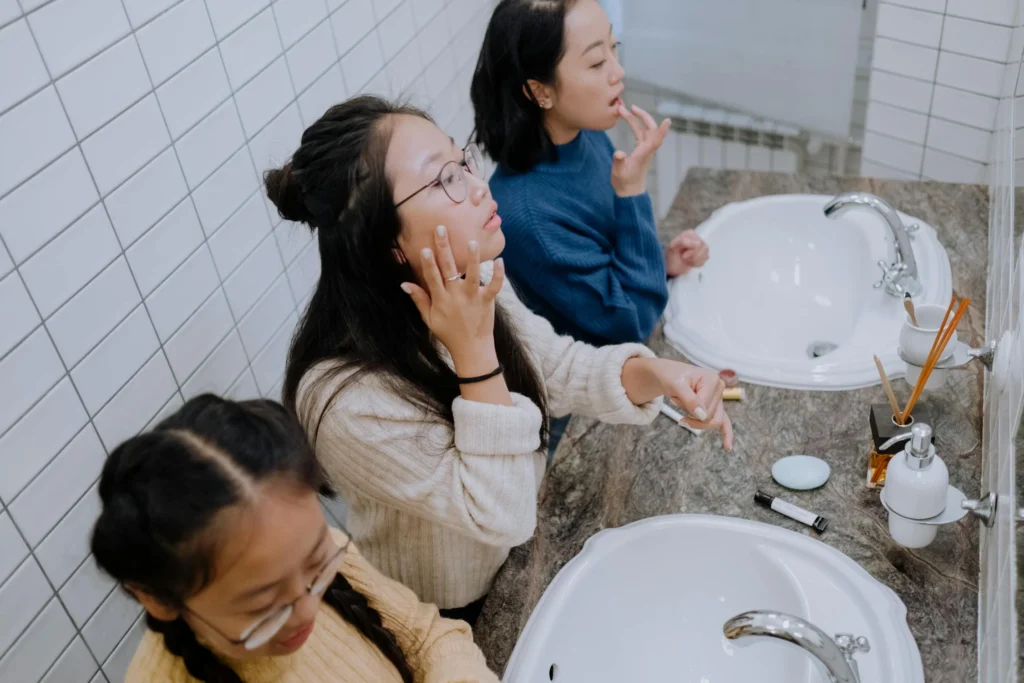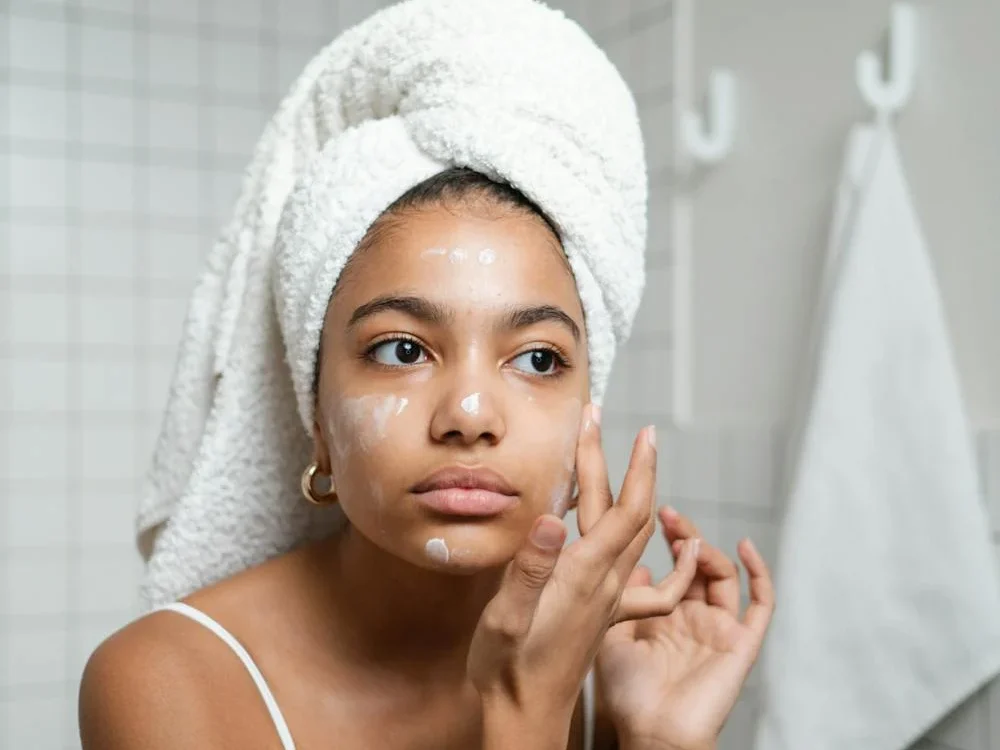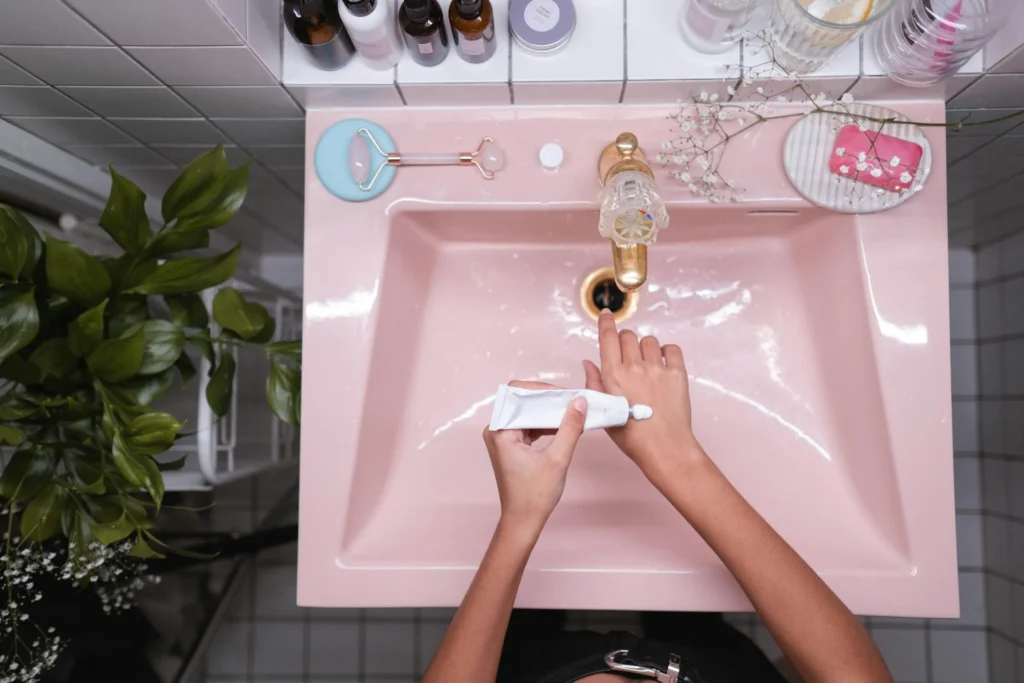News Team member Manju Karthikeyan discusses local efforts at Emory and Grady Memorial Hospital to improve awareness and outcomes for kidney disease across Georgia.
The Influence of Social Media on Kids’ Skin Health
Teens and tweens are flocking to beauty retailers for skincare products without knowing the risks.
By Ananya Dash

Skincare is all the rage among today’s young people. Skincare trends on TikTok lure children as young as eight years old to mimic their favorite celebrities, influencers, and peers.
Tweens (ages 9 to 12) and teenagers (ages 13 to 19), popularly called “Sephora Kids”, flock together to beauty stores with a long list of skincare products they wish to buy, one for every trend they see online. They aim to achieve “the clean girl aesthetic” trend with Drunk Elephant products or glass skin with a ten-step Korean skincare routine.
Young people, however, don’t realize how difficult it is to have “perfect” skin, especially with underlying skin conditions. They experiment with skincare products to target imperfections and participate in an exciting social trend, but those who fail to adhere to the unrealistic beauty standards can struggle with shame and social anxiety.
“Children start measuring themselves with how their skin looks on any particular day,” says Dr. Monisha Madhumita, a dermatologist, researcher and skin health advocate. “Even if you were to do the best procedures or use the best skincare products, you are not going to have great skin every day, and that’s okay.”
Acne is a rite of passage for most adolescents. About 85 percent of teenagers experience acne starting around the age of eleven. The online recommendations of endless products for their acne, however, can cause more harm than good.
Social media trends cannot replace medical advice from dermatologists. Lack of such guidance and the overwhelming echo chambers of social media convince teenagers try skincare products on their own accord without any real benefits. Such inappropriate use of products can even aggravate their skin and cause side effects.

Skincare meets social media
Teenagers spend an average of five hours every day on social media platforms including TikTok, Instagram, and YouTube, where they are likely to come across videos of skincare routines posted by influencers. The constant exposure to skincare content makes them keen on buying products that they don’t necessarily need.
But every viral trend is short-lived. Skincare influencers and brands profit from this strategy — if there is a skincare product trending today, it will be something else tomorrow. Young people fall for such endless trends.
“Children may not truly understand the ramifications of using such products on their skin health,” Madhumita says. “While adults, to some extent, can exercise their choice despite the damaging marketing strategies, children and minors often fail to exercise their choice voluntarily.”
In an article published last November in Pediatric Dermatology, Madhumita and co-author Dr. Subitchan Ponnarasu argue that skincare brands exploit children’s vulnerability to drive up their sales by violating ethical marketing practices. Exaggerated claims made by brands show up in distinct ways in consumers across the world.
For example, in countries such as India, these claims prey upon the obsession with light skin among adults and children. Skin-bleaching products are popular purchases, despite warnings by the International League of Dermatological Societies, a non-profit organization that works closely with the World Health Organization to promote advancement in dermatology science and education. These products contain steroids such as hydroquinone, which is available only by prescription in the US, that change skin pigmentation. This ingredient can lighten skin color immediately after use but leads to irreversible discoloration if used long-term.
Other products containing topical steroids and heavy metals are also available over the counter to consumers around the world. Long-term usage of such products can lead to skin thinning, skin disorders, and even penetration into the brain, leading to neurological effects.
In the US, cosmetic procedures, such as Botox treatments, have taken hold of the younger generation as a part of an obsession against aging. Botox, a brand name for botulinum injections, is used to smooth wrinkles and is common among those 40 and older. Yet between 2022 and 2023, Botox treatments rose by 9 percent among those 19 and younger, according to a report by the American Society of Plastic Surgeons. The former wrinkle treatment has been redubbed “preventative Botox” as younger generations without any wrinkles opt for it to prevent natural aging later on.
“I understand this is what you want but you don’t need this, come back to me in 15 years,” Dr. Shari Lipner, a dermatologist at Weill Cornell Medical College, says to young patients who request Botox treatments. She adds: “But there are non-dermatologists, who may not be well trained, but will still do these procedures.”

Skincare can be self-care
There is overwhelming evidence that the marketing strategies of the skincare industry have negative impacts on the mental health of young adults. Small-cohort studies, however, are emerging to paint a slightly different picture. These studies suggest that skincare routines can have positive impacts on the mental wellbeing of users. Those are in the context of facial treatments and massages, though — not skincare routines followed at home.
Dr. Hina Talib, a pediatrician and teen health expert, understands how this idea could extend to the multi-step skincare of young patients. It can be calming and centering. “We have been telling teens to take care of themselves for many years,” says Dr. Talib. “If it does not cause harm, I am actually supportive of a few of these steps. Young people tell me that it is a moment for them to practice self-care.”
Social media is an uncharted territory for many teens. They are exposed to thousands of products that may seem enticing. For example, influencers may glorify a product because they want people to click on links to buy it. Their goal is to earn money, not to provide an unbiased review.
Talib teaches her teen patients to be critical of information that they are getting from social media. She asks them to reflect upon their choices, and question influencers’ claim. Moreover, she urges them to read directions on packaging to better understand their product and even suggests affordable “dupes” that are equally effective as compared to their expensive counterparts.
“The onus is on parents, pediatricians, dermatologists, and brands to help guide young people to having conversations about what they actually need versus being influenced by what they think they might need,” Talib says.
Skincare necessities versus needs
Not every skincare product has harmful side-effects. The American Association of Dermatology recommends the use of moisturizers and sunscreens for everyone, starting at the age of six months. Moisturizers are excellent ways to protect the skin barrier by preventing water loss. Regular use of sunscreens reduces the chances of premature skin aging and cancer.
For tweens and teens, using a face wash, moisturizer, and sunscreen is more than enough. In fact, there is limited evidence that serums, toners, and other skincare products sold over the counter can treat skin conditions. These products do not go through stringent criteria to get approval by the Food and Drug Administration.
For example, tretinoin, a topical Vitamin A derivative that is dispensed by prescription, is well-known for treating acne in the younger population and preventing wrinkles in the older population, but there is no evidence that tretinoin can reverse skin aging in children even if they were to use it. Further, versions of Vitamin A sold over the counter may not have the same benefits as tretinoin due to differences in formulation and reduced Vitamin A content. Still, teenagers opt into a trend to treat their skincare conditions instead of visiting a dermatologist.
“Certain types of acne won’t respond at all to over-the-counter products,” Lipner says. “Over-the-counter products can be helpful for acne but should be used as part of a prescription plan explained by a board-certified dermatologist.” In a letetr published in August 2024 in the journal Skin Research and Technology, Lipner similarly urged adolescents to speak with their dermatologists to get appropriate recommendations for their skincare issues.
A new bill introduced in California takes an extreme approach to solve this problem. If passed, the bill would ban the sale of anti-aging products to kids under the age of 18. “Anti-aging products can lead to skin irritation, redness, breakouts, and even long-term damage,” states the release posted on the California State Assembly website.
Beauty industry representatives have criticized the proposed policy. “The bill is unlikely to alleviate the impact of social media trends,” a spokesperson for the Personal Care Products Council, a cosmetics industry group, said in an email. “It will overregulate and cause confusion among consumers by imposing sales restrictions on a wide variety of safe and effective products, including sunscreens, moisturizers, and hygiene products.”
It is true that teenagers also may not be able to tolerate specific anti-aging products, but some of these products also have anti-acne properties too. In these cases, young people need dermatologists to review both their over-the-counter and prescription product use to prevent them from being irritating to the skin.
Further, the intent to ban certain skincare products, such as the one in California, introduces barriers for over-the-counter products that are affordable, accessible without health insurance, and work as intended. Instead, brands should take the lead and be held accountable in reshaping the narratives around their skincare products.
The concept of skin health should be like practicing a balanced diet, getting good sleep, and exercising regularly. “We need to move to a place of skin neutrality –– not positivity –– to be able to approach skin health from a logical view point,” Madhumita says. “We should not romanticize it and make it seem bigger than it is.”

